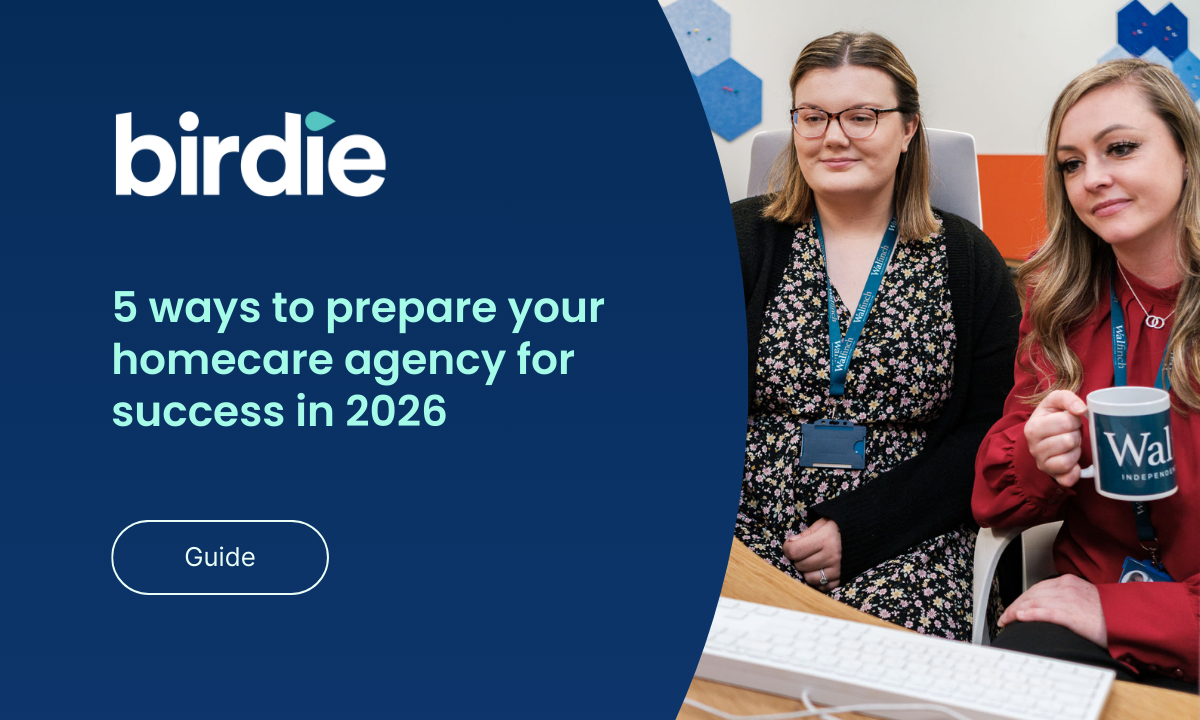Table of contents
COVID-19 has exacerbated the challenges faced by the social care industry. The Government and the public have seen first hand the issues but also the importance of our sector. Will it be a blessing in disguise?
On Thursday 20th August Birdie hosted our second roundtable discussion with industry leaders from the care sector as part of the 'Future of Homecare' series.
The Series has been created to bring together key industry leaders to discuss, challenge, and share insights across policy, provision and regulation. We believe that the best way to make progress in social care is to break through the silos and build a coalition of the willing to drive the changes that are needed.
We were thrilled to welcome Jane Towson, CEO of the United Kingdom Home Care Association (UKHCA) to join us for the discussion and share her insights on regulation in home care and the impact of technology on regulation.
Attended by industry leaders and key figures in the care sector from organisations including Right at Home, Caremark and Cera Care amongst others the discussion outlined some of the critical problems with the current regulatory framework and how we move forward in a tech-enabled world.
What is the purpose of regulation in home care?
Jane Townsen opened our discussion with the question “Do we need regulation in home care, and if so, why?”
The general public feels that services are regulated for public protection, but not every care service is regulated, for example, personal assistants aren’t. If we allow personal assistants to operate unregulated, it raises the question; is it necessary at all?
The CQC, the central regulatory body for health and social care, was set up in 2009 to regulate and encourage quality care standards of care providers. Still, there is an argument that within the CQC, there is a lot of variation and a lack of consistency.
“The difference in CQC inspectors means that one inspector could rate one of our offices outstanding, and another inspector could come along and say it requires improvement. The difference is that huge. The CQC is not particularly objective, and when you haven’t got that objectivity across the board, I’m challenged to understand how it moves with the times.”
Anne-Marie Perry, Abicare
Neil Grant suggests that we should be careful what we wish for - the current system of regulation is an update on the previous rigid requirements that came before it - but with a loosening of the conditions comes subjectivity. By basing outcomes and ratings on a personal interpretation of the KLOEs, it allows for more freedom and flexibility, but also incorporates opinion-led decisions, which is where we see the issues mentioned above.
Does the fear of regulation affect home care and registered services?
With regulation comes the possibility of criminal action when things go wrong. In a sector that needs more and more workforce each day, is regulation turning people away from the role?
During the discussion, it was mentioned that finding new Registered Managers was difficult. So tricky in fact, that some mentioned that they were expanding their offering from regulated, domiciliary care, to also include an introductory service for personal assistants. This model, of course, is not regulated, as the provider does not employ the care workers.
We know that with so much regulation, Registered Managers often become stressed and burn out. They have a significant level of responsibility, and they aren’t paid particularly well. The market can’t sustain that. And on top of that, when they burn out - they take the team with them - and then the stability of that workforce is also compromised.
We need to look at ways to support them, rather than govern them with regulation that ultimately can lead to failure or low ratings that impact their business.
How COVID-19 has impacted regulation
COVID-19 has meant that regulation has changed in several ways. Has this been for the better? Are there any lessons we can learn from the pandemic?
The ESF calls and guidance proved to be ineffective for many - and whilst framed by the CQC as a helpful service, aimed at supporting the care industry many, like Anna Whiteside of Caremark, felt “these didn’t lead to outcomes. It seemed like the CQC were ‘ticking the boxes’, but the providers didn’t see a benefit.”
Regulation before COVID-19 also put a significant emphasis on hours of care and punctuality. During COVID-19, these stringent processes seemed all but abandoned - and yet care continued at a high level of quality, with no interruption.
A question raised during the discussion asked whether the information the CQC required pre-COVID-19 was used correctly.
Most of the participants agreed that metrics like hours of care delivered and timekeeping statistics were an ineffective measure of care quality. And COVID-19 has only strengthened the questioning around why the CQC requires this information to regulate care quality when these metrics are not currently considered (as a result of COVID-19).
Who should be regulating care?
We see many different ways of regulating care delivery across different countries. In other countries like Spain, the LAs maintain the oversight of quality of care. In Scandinavian countries, they use professional registration competency. In the US, they use a data-driven approach, where all care providers must submit data centrally. In RI there is no regulation, but they’re moving towards it because of various scandals that have been uncovered, and this seems to be the driving force in regulation.
We have a lot of duplication in this country - local authorities do contract monitoring, and the CQC have their own methods for regulation - but is there a better way to regulate?
Jonathan Vellacott of MiHomecare highlighted a significant concern with unregulated services:
“The problem with regulated vs unregulated services is that when things are unregulated, it becomes hidden. The most important thing is in making sure that the most vulnerable people in our society are protected - the danger is that without regulation, we risk people slipping through the net. We’re unable to keep a check on the quality of care being delivered. For example, personal assistants who don’t fall into the bracket that requires regulation.”
But, does regulation have to be in the form of a regulatory body that inspects and publishes ratings like the CQC? If the CQC isn’t regulating effectively, is there another option? Could home care regulate differently? Could self-regulation or individual registration be the answer?
We know that it has worked elsewhere, but due to budgets and time constraints, individual registrations don’t seem to be in the pipeline any time soon. So what else can we do? Can technology help within regulation? Can it allow us to bypass the subjectivity and use data-driven metrics to measure care quality?
What role does technology play in regulation?
When we consider a self-sufficient model for regulation, it’s easy to see the role that technology has in ensuring we meet minimum standards. But how much should we rely on technology? How can we regulate outcomes with the data we have already? And how can we be sure that the regulators are using that data correctly?
“If we truly measure outcomes, we can do this with technology. Removing the regulation means you have opportunities to work closely with your client and be more flexible. As long as you meet those minimum 16 care standards - basic principles - are the clients at greater risk if it's a managed service or not? And if we have the appetite for it, we know that technology can help”
Anne Marie Perry, Abicare
Whilst it’s clear that there can be benefits to technology in home care if the regulators don’t adapt and change to our new models of working there is a risk that the technology could hinder rather than help. We need to strive for an outcomes-based approach powered by data that moves away from cost and timings as the sole indicator for quality.
As we move into a more tech-based environment, it’s clear that CQC is not using current data correctly to inform their decisions. They’re dealing with an old framework that relies on time and cost, which doesn’t encompass the whole picture of service delivery. But, on the other hand, a point raised by Ken Deary of Right at Home suggests that “there is a danger that when we assign data to care quality, “we sit behind computers and don’t see the quality of care. We don’t see the care being delivered so we can’t know the quality.”
It seems that to move forward, we need regulators to rethink their models and use a dual approach that factors in the right data alongside human observations. We know that data can help us to build outcome-based models of care, but as yet, regulation hasn’t caught up with this approach - and there’s still much work to be done. Providers need to embrace digital solutions as a way to empower their teams. Instead of becoming an exercise in ticking boxes and hitting numerical targets, we can rethink the way we deliver and regulate care.
In summary:
Our current system of regulation isn’t working for our fragmented sector. We need to make a change. We need to agree on a new way to measure care quality.
We know that data and technology will become more prevalent in the care industry, but how do we use that information to support and help us provide the best care? The CQC have implied a digital-forward approach as of 2021, but questions remain around what that means and how they’ll use digital to support care quality regulation.
At the moment councils primarily commission care for 'process' (based on things like time and task, e.g. 15-minute units of visits), and we regulate in the same way too. The real measure of good quality care is whether it helps a person to achieve their goals/outcomes. These goals should be focused on keeping people independent and at home for longer; for example, rehabilitating someone to walk again after a fall, or resume normal activities like shopping or personal care.
To achieve genuinely outcome-based care regulation, (and delivery packages) councils and agencies need to monitor against these outcomes more, which rarely happens today, but could be made possible with the support of digital. Technology, like home monitoring and software systems, could be a useful tool in evidencing care and highlighting changes over time in a structured way.
Only when we address these issues and work together with local authorities to map new ways to measure care delivery that doesn’t rely on a pay-by-minute system, can we then make changes to the way we regulate.
Birdie would like to extend a warm and heartfelt 'thank you' to Jane Townsen for a very enlightening discussion. We would also like to thank all the Homecare Leaders who joined us for this session in our Future of Homecare Series.
We'll be running these sessions regularly, so be sure to keep an eye on our social channels: Twitter, Facebook, Linkedin & Instagram.
Published date:
September 9, 2020
Author:
Emma-Lee

















.svg)